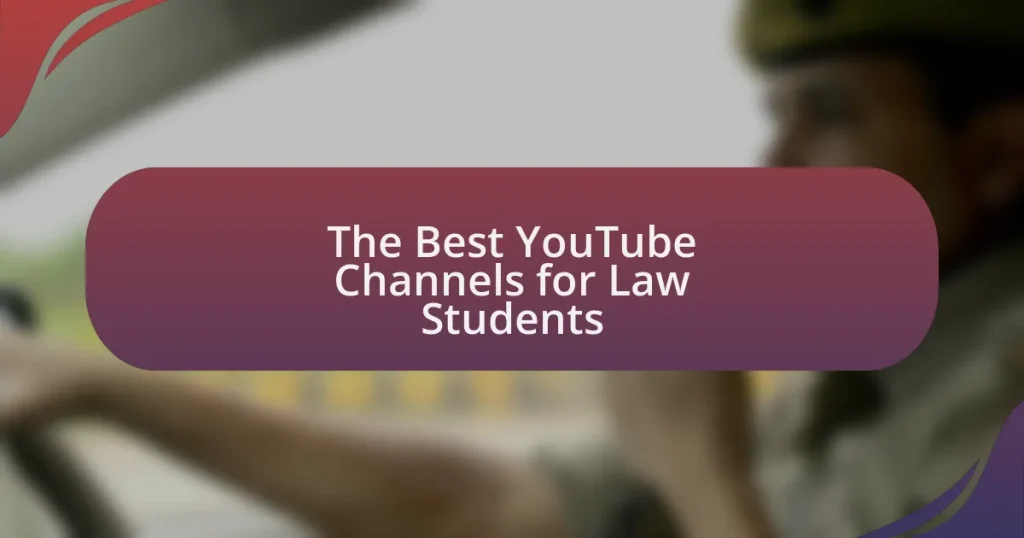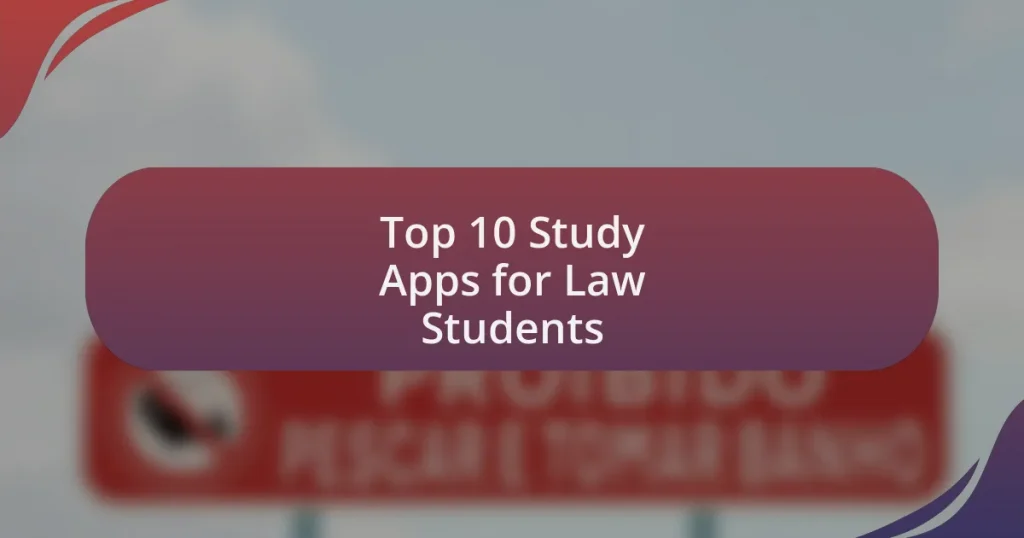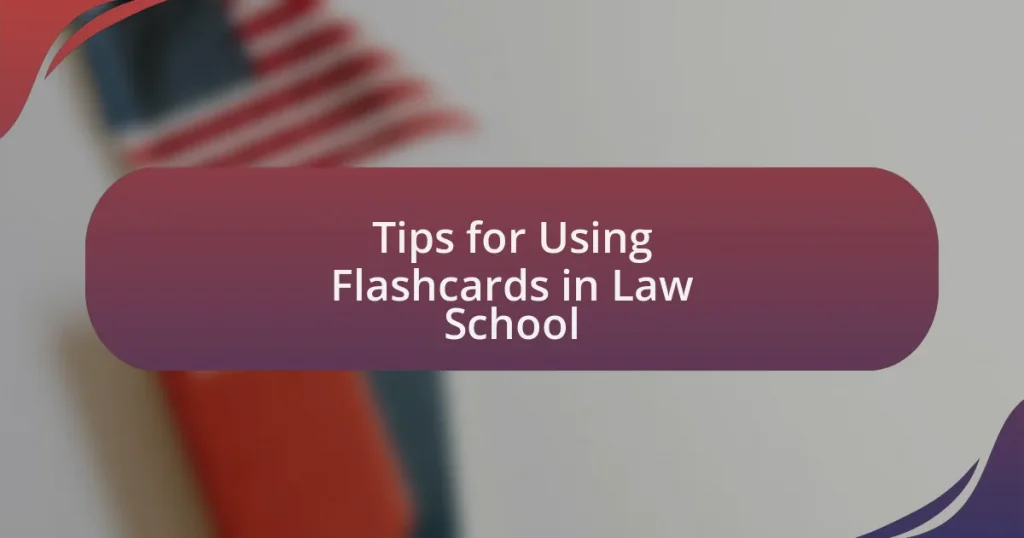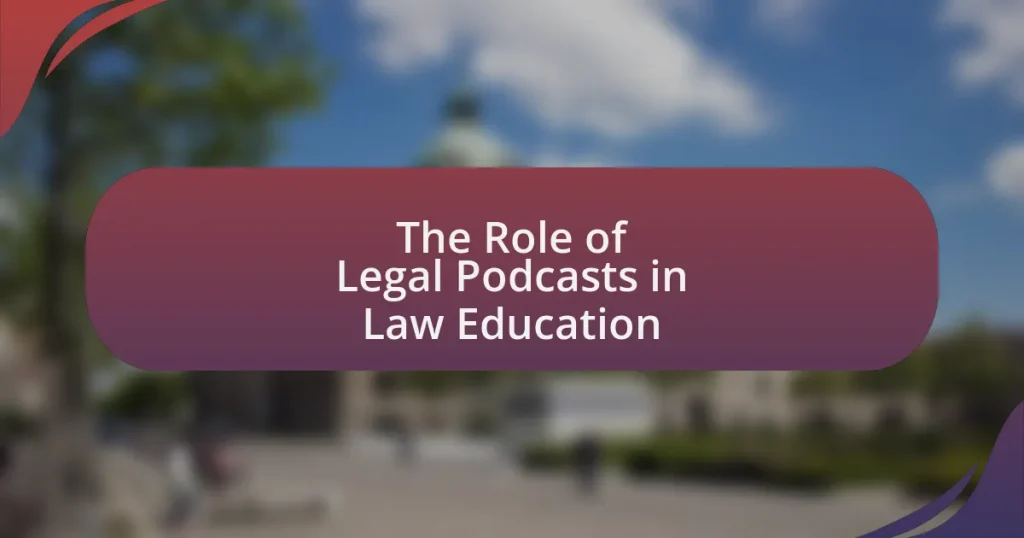The article focuses on the best YouTube channels for law students, highlighting channels such as LegalEagle, The Law Simplified, and Harvard Law School’s channel. It discusses how YouTube enhances the learning experience by providing diverse educational content, including legal analysis and exam preparation strategies. The article outlines the types of content offered by these channels, the importance of creator credibility, and the impact of visual learning on legal education. Additionally, it provides practical tips for law students on effectively utilizing YouTube in their studies, including strategies for note-taking and avoiding distractions.
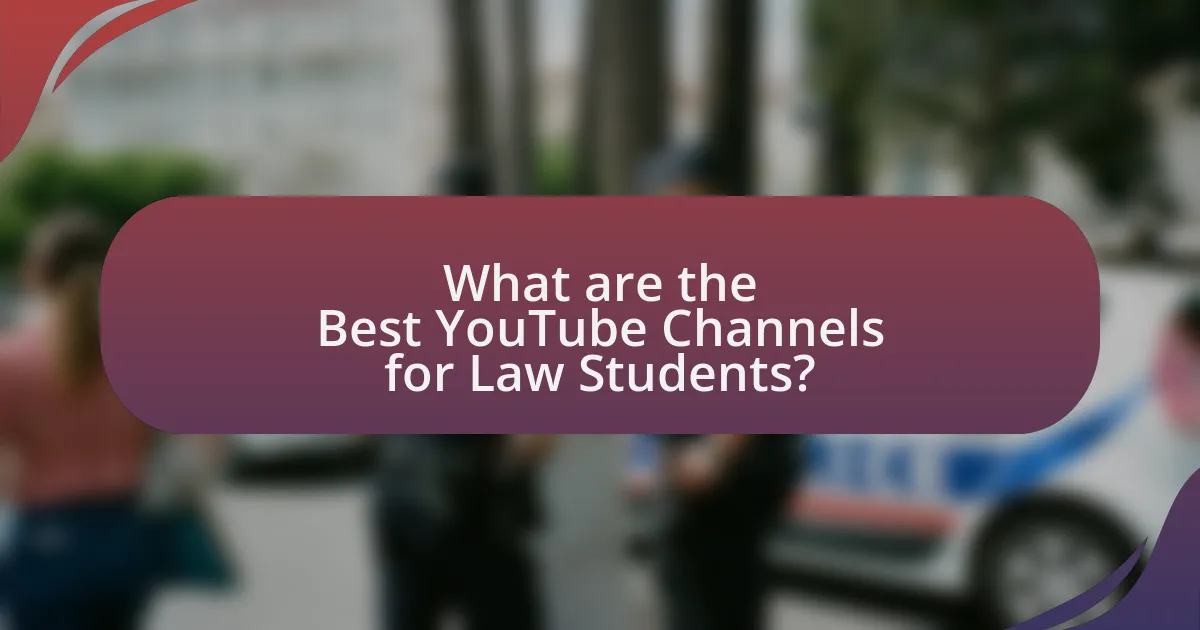
What are the Best YouTube Channels for Law Students?
The best YouTube channels for law students include LegalEagle, The Law Simplified, and Harvard Law School’s channel. LegalEagle offers practical insights into legal concepts and case law, making it accessible for students. The Law Simplified breaks down complex legal topics into understandable segments, which is beneficial for exam preparation. Harvard Law School’s channel features lectures and discussions from esteemed professors, providing a high-level academic perspective. These channels are widely recognized for their educational value and have garnered positive feedback from law students for enhancing their understanding of legal principles.
How can YouTube enhance the learning experience for law students?
YouTube can enhance the learning experience for law students by providing access to a vast array of educational content, including lectures, case studies, and legal analysis. This platform allows students to engage with diverse perspectives from legal experts and educators, facilitating a deeper understanding of complex legal concepts. For instance, channels like LegalEagle and The Law Simplified offer detailed breakdowns of legal principles and current events, which can reinforce classroom learning. Additionally, the visual and auditory elements of video content cater to different learning styles, making it easier for students to grasp intricate topics. Research indicates that multimedia resources can improve retention rates and comprehension, further validating YouTube’s role as a valuable educational tool for law students.
What types of content do law-related YouTube channels typically offer?
Law-related YouTube channels typically offer educational content, legal analysis, and practical advice. These channels often feature topics such as case law breakdowns, legal principles, exam preparation tips, and discussions on current legal issues. For instance, channels like LegalEagle provide detailed explanations of legal concepts and case studies, while others may focus on career advice for aspiring lawyers. This variety caters to law students and professionals seeking to enhance their understanding of the legal field.
How does visual learning impact law education?
Visual learning significantly enhances law education by improving comprehension and retention of complex legal concepts. Research indicates that visual aids, such as diagrams and videos, facilitate better understanding of intricate legal frameworks and case law. For instance, a study published in the Journal of Legal Education found that students who engaged with visual learning materials scored 20% higher on assessments compared to those relying solely on text-based resources. This demonstrates that incorporating visual elements in law education can lead to more effective learning outcomes.
What criteria should be considered when selecting YouTube channels for law studies?
When selecting YouTube channels for law studies, consider the credibility of the content creators, the relevance of the topics covered, and the quality of the production. Credibility can be assessed by the educational background and professional experience of the channel hosts, such as whether they are practicing lawyers or law professors. Relevance involves ensuring that the channel addresses current legal issues, foundational legal principles, and exam preparation materials. Quality of production includes clear audio and video, engaging presentation styles, and well-structured content that enhances learning. These criteria ensure that the selected channels provide accurate, useful, and engaging legal education.
How important is the credibility of the channel’s creator?
The credibility of the channel’s creator is crucial for law students seeking reliable information. A credible creator enhances trustworthiness, ensuring that the content is accurate and relevant to legal studies. Research indicates that viewers are more likely to engage with and learn from content produced by individuals with recognized expertise or qualifications in the field, such as law degrees or professional experience. This is particularly important in legal education, where misinformation can lead to misunderstandings of complex legal concepts. Therefore, the creator’s credibility directly impacts the educational value of the channel for law students.
What role does the channel’s content quality play in its effectiveness?
The channel’s content quality is crucial for its effectiveness, as high-quality content engages viewers, enhances learning, and builds credibility. Effective channels provide accurate, well-researched, and relevant information that resonates with law students, facilitating better understanding of complex legal concepts. For instance, a study by the Pew Research Center indicates that 73% of YouTube users believe that video quality significantly impacts their learning experience. Therefore, channels that prioritize content quality are more likely to attract and retain an audience, ultimately leading to greater educational impact.
Which popular YouTube channels are highly recommended for law students?
Highly recommended YouTube channels for law students include LegalEagle, The Law Simplified, and Law by Mike. LegalEagle provides detailed analyses of legal concepts and case law, making complex topics accessible. The Law Simplified focuses on breaking down legal principles and exam strategies, which is beneficial for students preparing for assessments. Law by Mike offers practical insights into the legal profession and real-world applications of law, enhancing students’ understanding of their future careers. These channels are popular among law students for their engaging content and educational value.
What unique features do channels like LegalEagle offer?
Channels like LegalEagle offer unique features such as detailed legal analysis of popular media, educational content that simplifies complex legal concepts, and interactive Q&A sessions that engage viewers. LegalEagle specifically breaks down legal cases and principles using examples from movies and television, making the content relatable and easier to understand for law students. Additionally, the channel provides insights into the legal profession, including tips for aspiring lawyers, which enhances its educational value.
How does the content of The Law Simplified cater to law students?
The content of The Law Simplified caters to law students by providing clear, concise explanations of complex legal concepts. This channel breaks down intricate topics into easily digestible segments, making it accessible for students who may struggle with traditional legal texts. Additionally, The Law Simplified utilizes visual aids and practical examples, which enhance understanding and retention of legal principles. The channel’s focus on exam preparation strategies and real-world applications further supports law students in their academic journey, ensuring they grasp essential knowledge needed for their studies and future careers.
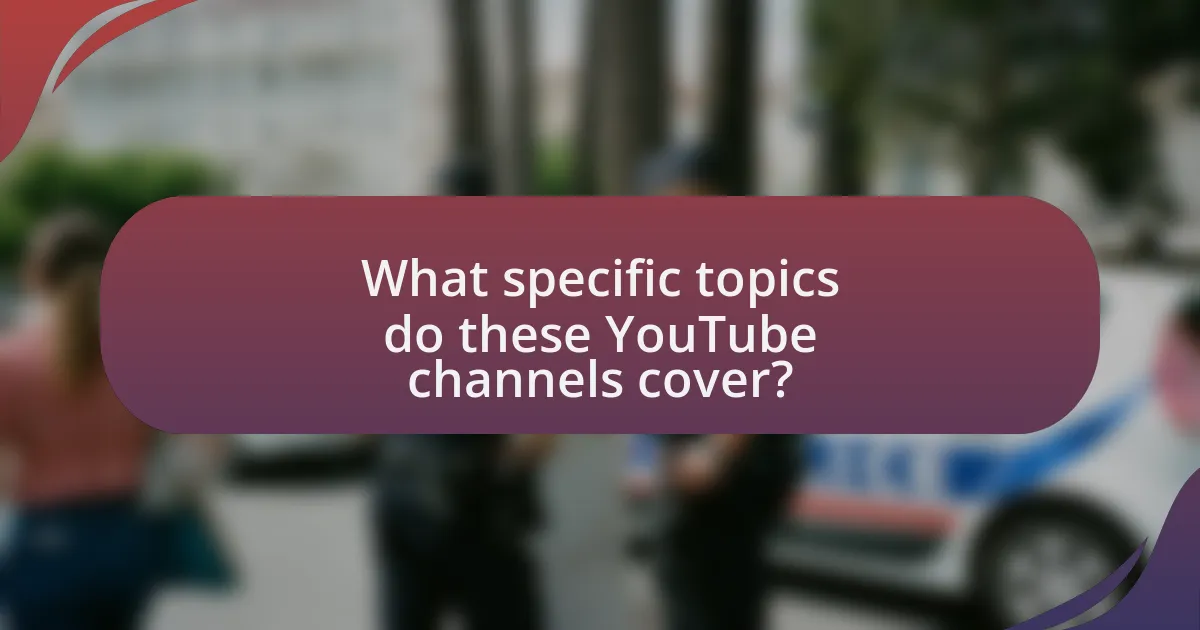
What specific topics do these YouTube channels cover?
The specific topics covered by YouTube channels for law students include legal concepts, case law analysis, exam preparation strategies, and insights into legal careers. These channels often provide tutorials on subjects such as constitutional law, criminal law, and contract law, along with practical advice on studying effectively and understanding complex legal principles. For instance, channels may feature discussions on landmark Supreme Court cases or offer tips for succeeding in law school exams, thereby equipping students with both theoretical knowledge and practical skills essential for their legal education.
How do these channels address core legal concepts?
These channels address core legal concepts by providing accessible explanations and analyses of complex legal principles. For instance, channels like LegalEagle break down case law and legal theories through engaging video content, making it easier for law students to grasp foundational concepts such as torts, contracts, and constitutional law. Additionally, channels often utilize real-world examples and current events to illustrate how these legal concepts apply in practice, enhancing understanding and retention. This method of teaching aligns with educational research indicating that contextual learning improves comprehension and application of legal knowledge.
What foundational legal principles are commonly discussed?
Foundational legal principles commonly discussed include the rule of law, due process, and the separation of powers. The rule of law asserts that all individuals and institutions are accountable to the law, ensuring fairness and justice. Due process guarantees that legal proceedings are conducted fairly and that individuals have the right to be heard. The separation of powers divides government responsibilities into distinct branches to prevent any one branch from exercising too much power, promoting checks and balances. These principles are essential for maintaining a just legal system and are frequently referenced in legal education and discussions.
How do these channels explain complex legal theories?
These channels explain complex legal theories through accessible visual content, simplified language, and practical examples. For instance, channels like LegalEagle and The Law Simplified break down intricate concepts such as constitutional law and torts by using real-world cases and relatable scenarios, making the material easier to grasp for students. Additionally, these channels often utilize animations and graphics to illustrate legal principles, enhancing comprehension and retention of the information presented.
What practical skills can law students learn from these channels?
Law students can learn critical thinking, legal research, and effective communication skills from these channels. These practical skills are essential for analyzing complex legal issues, conducting thorough research to support legal arguments, and articulating those arguments clearly in both written and oral formats. For instance, channels that focus on case law analysis provide insights into how to dissect legal opinions, enhancing critical thinking. Additionally, tutorials on legal writing and advocacy techniques help students develop their communication skills, which are vital for success in legal practice.
How do channels provide insights into legal writing and research?
Channels provide insights into legal writing and research by offering accessible content that breaks down complex legal concepts and methodologies. These platforms often feature expert discussions, case studies, and practical examples that enhance understanding of legal principles. For instance, channels dedicated to legal education frequently analyze landmark cases and demonstrate effective legal writing techniques, which can improve students’ research skills and writing proficiency. Additionally, many channels provide resources such as templates and guides that are directly applicable to legal writing tasks, reinforcing the learning process through practical application.
What tips do these channels offer for effective exam preparation?
These channels offer several tips for effective exam preparation, including creating a study schedule, utilizing active recall techniques, and practicing past exam papers. A structured study schedule helps students allocate time efficiently across subjects, ensuring comprehensive coverage of material. Active recall, which involves testing oneself on the material rather than passively reviewing notes, has been shown to enhance retention and understanding. Additionally, practicing past exam papers familiarizes students with the exam format and types of questions, improving their confidence and performance.
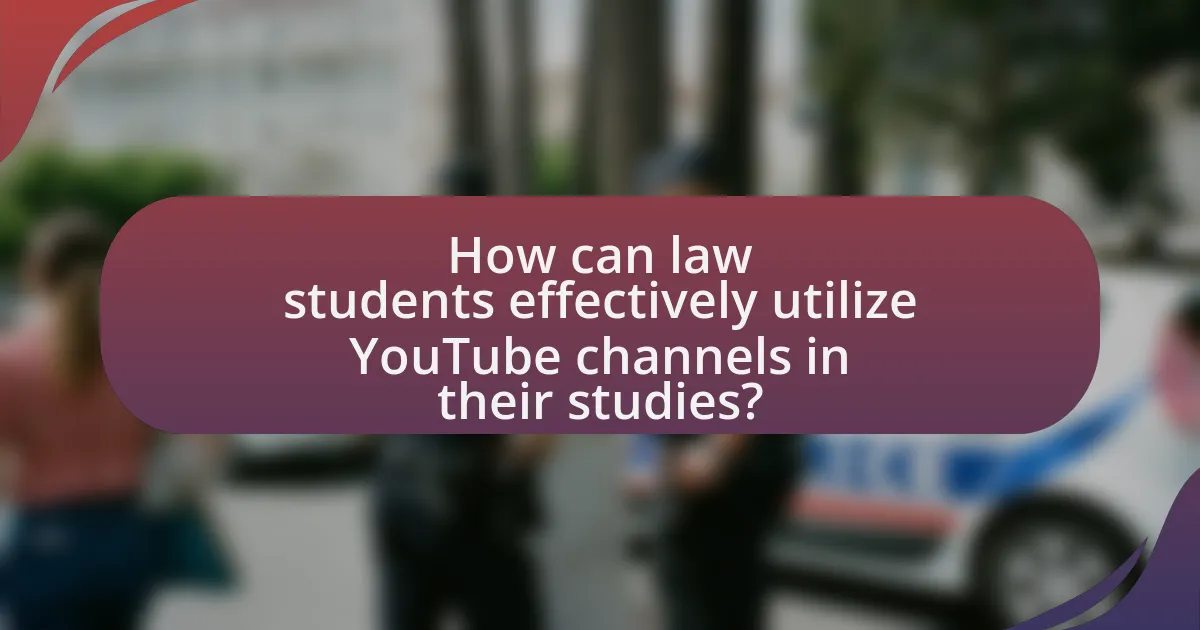
How can law students effectively utilize YouTube channels in their studies?
Law students can effectively utilize YouTube channels in their studies by engaging with content that covers legal concepts, case law, and exam preparation strategies. By subscribing to reputable channels, students can access lectures, tutorials, and discussions that enhance their understanding of complex legal topics. For instance, channels like LegalEagle and The Law Simplified provide clear explanations and practical insights into various areas of law, which can reinforce classroom learning. Additionally, students can use YouTube to find visual aids and real-world applications of legal principles, making the material more relatable and easier to grasp. This method of learning complements traditional study techniques and caters to different learning styles, ultimately improving retention and comprehension of legal material.
What strategies can enhance the learning experience from YouTube?
To enhance the learning experience from YouTube, viewers should actively engage with the content by taking notes and summarizing key points. This strategy promotes retention and understanding, as studies show that active learning techniques, such as note-taking, can improve information recall by up to 30%. Additionally, viewers can utilize playlists to organize videos by topic, allowing for a structured learning path. Engaging with the community through comments and discussions further deepens comprehension, as peer interaction can clarify concepts and provide diverse perspectives.
How can students integrate YouTube content with traditional study methods?
Students can integrate YouTube content with traditional study methods by using video resources to supplement textbooks and lectures. For instance, students can watch YouTube videos that explain complex legal concepts, which can enhance their understanding of the material covered in class. Research indicates that multimedia learning, such as combining visual and auditory information, can improve retention and comprehension (Mayer, 2001). By taking notes while watching relevant videos, students can create a more interactive study experience that reinforces their learning. Additionally, students can engage in discussions about the video content with peers, further solidifying their grasp of the subject matter.
What are the best practices for taking notes while watching legal videos?
The best practices for taking notes while watching legal videos include actively summarizing key points, using bullet points for clarity, and timestamping important segments for easy reference. Active summarization helps reinforce understanding and retention of complex legal concepts, while bullet points allow for quick scanning of information. Timestamping enables viewers to revisit specific sections of the video for deeper analysis or clarification, enhancing the overall learning experience. These methods are effective because they align with cognitive learning theories that emphasize active engagement and structured information processing.
What common pitfalls should law students avoid when using YouTube for study?
Law students should avoid distractions, misinformation, and lack of critical engagement when using YouTube for study. Distractions arise from the platform’s algorithm promoting unrelated content, which can lead to wasted time. Misinformation is prevalent, as not all videos are created by credible sources; students must verify the qualifications of the content creators. Additionally, a lack of critical engagement means students may passively consume information without actively analyzing or questioning it, which is essential for mastering legal concepts. These pitfalls can hinder effective learning and retention of material necessary for success in law school.
How can students discern credible sources from unreliable ones?
Students can discern credible sources from unreliable ones by evaluating the author’s credentials, checking the publication date, and assessing the source’s citations. Credible sources typically have authors with relevant expertise, such as law degrees or professional experience in the legal field, which enhances their reliability. Additionally, recent publication dates indicate that the information is current and relevant, especially in a rapidly evolving field like law. Furthermore, credible sources often cite other reputable works, demonstrating a foundation of research and validation. For instance, a YouTube channel that features licensed attorneys discussing legal principles and referencing established legal texts would be considered more credible than one lacking such qualifications and citations.
What distractions should be minimized while studying with YouTube?
To maximize focus while studying with YouTube, distractions such as notifications from social media, unrelated video recommendations, and multitasking should be minimized. Notifications from social media can interrupt concentration, leading to decreased retention of information. Unrelated video recommendations can divert attention away from the intended study material, causing time loss and confusion. Multitasking, such as checking emails or browsing other websites while watching educational videos, can hinder cognitive processing and reduce overall learning effectiveness. Research indicates that multitasking can decrease productivity by up to 40%, emphasizing the importance of maintaining a singular focus during study sessions.
What are some tips for maximizing the benefits of YouTube for law students?
To maximize the benefits of YouTube for law students, they should actively engage with content by subscribing to reputable law channels, participating in discussions, and utilizing playlists for structured learning. Engaging with channels like LegalEagle and The Law Simplified provides access to expert insights and practical legal knowledge. Additionally, law students can enhance their understanding by watching lectures and tutorials that cover specific legal topics, which often include real-world applications and case studies. This approach not only reinforces theoretical knowledge but also helps in developing critical thinking skills essential for legal practice.
How can students create a personalized playlist of useful channels?
Students can create a personalized playlist of useful channels by first identifying their specific interests and needs within the law field. They should then search for YouTube channels that align with those interests, such as channels focused on legal theory, case studies, or exam preparation. After finding relevant channels, students can subscribe to them and use the YouTube playlist feature to compile videos from these channels into a single, organized playlist. This method allows for easy access to curated content that supports their learning objectives.
What role does community engagement play in enhancing learning through YouTube?
Community engagement significantly enhances learning through YouTube by fostering interactive discussions and collaborative learning experiences. Engaged communities provide feedback, share diverse perspectives, and create a supportive environment that encourages deeper understanding of complex legal concepts. For instance, channels that actively involve their audience through Q&A sessions or comment discussions can lead to improved retention of information, as learners feel more connected and invested in the material. Research indicates that active participation in online communities can enhance motivation and learning outcomes, making community engagement a vital component in educational contexts on platforms like YouTube.
